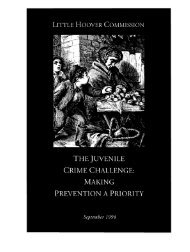Jailhouse Lawyer's Handbook - Sentencing and Justice Reform ...
Jailhouse Lawyer's Handbook - Sentencing and Justice Reform ...
Jailhouse Lawyer's Handbook - Sentencing and Justice Reform ...
Create successful ePaper yourself
Turn your PDF publications into a flip-book with our unique Google optimized e-Paper software.
Chapter Three: How to Start<br />
Your Lawsuit<br />
This chapter explains how to start a lawsuit under<br />
Section 1983. It explains what legal papers to file,<br />
when, where, <strong>and</strong> how to file them, <strong>and</strong> it provides<br />
forms to guide your writing. It also explains what to do<br />
in an emergency, when you need immediate help from<br />
the court. The next<br />
chapter, Chapter<br />
Four, discusses what<br />
happens after a suit<br />
is started. Neither<br />
chapter gives all the<br />
rules or procedures<br />
for this kind of suit.<br />
These details are in<br />
the Federal Rules of<br />
Civil Procedure<br />
issued by the U.S.<br />
Supreme Court. The<br />
Federal Rules are<br />
supposed to be in<br />
TIP: Before you start writing<br />
your complaint, request the<br />
following documents from<br />
your District Court:<br />
1. The District Court’s Local<br />
Rules;<br />
2. Forms for a Section 1983<br />
pro se action;<br />
3. In Forma Pauperis forms;<br />
4. Forms for Appointment of<br />
Counsel.<br />
your prison library as part of Title 28 of the United<br />
States Code Annotated (U.S.C.A.). The U.S.C.A. gives<br />
short summaries of important court decisions which<br />
interpret each rule. Chapter Six explains how to use the<br />
U.S.C.A. <strong>and</strong> other law books.<br />
The Federal Rules are not too long <strong>and</strong> they are very<br />
important. When we refer to a specific rule in this<br />
<strong>H<strong>and</strong>book</strong>, you should read the rule if you possibly can.<br />
The rules are revised every few years, so be sure to<br />
check the “pocket parts” in the back of the books in the<br />
U.S.C.A. or read a current copy of the paperback. You<br />
may find reading the rules frustrating, since they are<br />
written in very technical language, <strong>and</strong> even lawyers<br />
<strong>and</strong> judges can’t always agree on what they mean. For<br />
this reason, you may want to read a book that explains<br />
the Federal Rules <strong>and</strong> court decisions that interpret the<br />
Rules. If your library has it, a good book to read is<br />
Wright <strong>and</strong> Miller’s Federal Practice <strong>and</strong> Procedure.<br />
You may also want to read the Advisory Committee<br />
notes which are printed in some editions of the rules.<br />
These notes explain the purpose of the rules <strong>and</strong> how<br />
they are supposed to work.<br />
In addition to the Federal Rules, each United States<br />
District Court issues “Local Rules of Practice,” which<br />
are based on the Federal Rules. The Local Rules cover<br />
details of procedure that may be different in each<br />
particular district. You can get a copy from the Clerk<br />
of the U.S. District Court for each district, but you may<br />
have to pay a small fee. You may want to request these<br />
rules when you write the court to get forms (explained<br />
below). Look in Appendix H to find the address of<br />
your District Court. Or, if you have a friend or relative<br />
with internet access, he or she can download the rules<br />
for free from the specific District Court’s website.<br />
A. WHEN TO FILE YOUR SECTION 1983 SUIT<br />
If you are trying to stop an official policy or practice<br />
within the prison, you will, of course, want to act as<br />
quickly as possible. If a rule has been issued or an<br />
official decision has been made, you do not need to<br />
wait until the new procedure is put into effect. You can<br />
sue right away to block it.<br />
If you are suing mainly to recover damages for an<br />
abuse that has already ended, you may not be in such a<br />
hurry. But it is usually best to get your suit going<br />
before you lose track of important witnesses or<br />
evidence.<br />
1. Statute Of Limitations<br />
For damage suits there is a “statute of limitations”<br />
which sets a deadline for how long you can wait, after<br />
the events occurred, before you start your suit. If your<br />
time runs out your case is “time-barred,” which means<br />
you will not be able to bring it. To meet a statute of<br />
limitations, you need to file your suit before the<br />
deadline. The deadline for a Section 1983 suit is<br />
determined by your state’s general personal injury<br />
statute. Owens v. Okure, 488 U.S. 235, 236 (1989).<br />
This same rule applies to Bivens actions brought by<br />
federal prisoners. In some states, the statute of<br />
limitations is as short as one year, but most states give<br />
two or more years. Statutes of limitations can change,<br />
so always check current state statutes to make sure. To<br />
discover the statute of limitations in your state, look in<br />
the “civil code” or “civil procedure” section of the state<br />
code.<br />
If you expect to get out of prison fairly soon – for<br />
example, you already have a parole date – then you<br />
might be better off waiting until you are out before you<br />
start a suit that is only for damages. You will<br />
obviously have more freedom to get your suit together<br />
when you’re out, <strong>and</strong> you’ll have access to a more<br />
complete law library. You may be able to raise the<br />
money to hire a lawyer, <strong>and</strong> prison officials will have a<br />
harder time getting back at you for filing suit. Also,<br />
some sections of the PLRA do not apply to prisoners<br />
who have been released.<br />
You do not have to worry about the statute of<br />
limitations if you have a suit for an injunction, because<br />
JAILHOUSE LAWYERS HANDBOOK – CHAPTER THREE<br />
36





